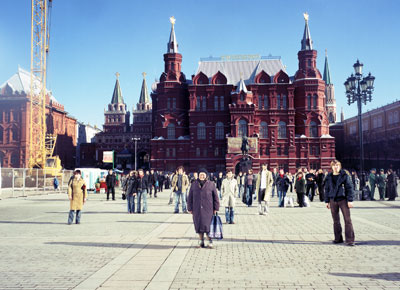 Manege, 3.23pm, from Groups and Locations (Moscow), 2004 Melanie Manchot Stories from Russia The Photographers' Gallery is showing new work by Melanie Manchot made in Moscow during the last 18 months. The exhibition consists of "Groups and Locations (Moscow)", a series of colour photographs, and the seven-channel video work "Hotel Moscow". In both works, Manchot instigates encounters using photography and video to explore how Russia's volatile history is embedded in the memories of its people and marks the contemporary city and its population. "Groups and Locations (Moscow)" and "Hotel Moscow" both hinge on Manchot's construction of situations in which contemporary Russians both perform and reveal themselves. The resulting photographs and video sequences are intriguing versions of portraiture that consciously draw together contemporaneity and history, private and public, individual and collective ideas about Russia and its citizens. In "Hotel Moscow", Muscovites are shown recalling their versions of the story about one of the city's most infamous landmarks. Commissioned by Stalin in the 1930s, the building housed visiting dignitaries close to Red Square. Its bizarre façade was made up of two contrasting architectural schemes. This asymmetry has been a subject of controversy since its construction, heightened by the hotel's current demolition and proposed re-building. The story of Hotel Moscow centres on Stalin's failure to recognise that he was presented with a choice of two building plans, both of which he signed, leaving his staff fearful of pointing out his mistake and with no option other than to construct the hotel using elements from both designs. In Manchot's video piece, six Muscovites, recount their version of the history of this architectural symbol. The interviewees come from a variety of social backgrounds, professions and age groups and their differing stories draw out and question how we individually construct and reconstruct history. Using the legacy of Stalinism as a metaphor for the personalisation of historical events, these videos are also revealing portrayals of each of the sitters. "Hotel Moscow" was filmed in the small, private yet social spaces of the interviewees' homes. The display of their individual identities is portrayed as much in their mannerisms and the decor of their homes, as in their personalised telling of the story of Hotel Moscow. In the context of Manchot's video work, both the physicality of the interviewees and the display of their domestic spaces are important clues towardsour comprehension of the slippages and differences between personal or private versions of political history. Towards the end of the video loop, these narrations are merged together, creating an overwhelming cacophony of speech and text, where the boundaries between information and chaos, between fact and fiction, are dissolved. "Groups and Locations (Moscow)" is a series of photographs that Melanie Manchot took at historic sites in and around Moscow. Their relationship with Russian history lies not only in the choice of locations but also in the composition of the photographs. For a country spread through Eastern Europe and Central Asia, photography in the mid-19th century played an important role in Russian people's comprehension of what their vast land and its inhabitants looked like. Figures were often positioned in prominent groups in the foreground of the part-topographic, part-ethnographic representations of Imperial Russia. "Groups and Locations (Moscow)" takes this particularly Russian photographic form as a cue for structuring contemporary group portraits that are similarly striking in the intensity of a collected group staring, their looking focused into the camera. Manchot set up her camera at public sites inviting passers-by to join the photographic shoot and to become part of a spontaneous group. The people shown in "Groups and Locations (Moscow)" were consciously agreeing to participate in, and act out, a moment of intervention. In a culture where photography is still viewed as problematic, and in designated public spaces is restricted or even prohibited, the participation of the passers by has a political charge. The current preliminary bill restricting public protests and demonstrations in or near public sites of political importance similarly adds to these photographic performances a real interlinking of contemporary Russia with its history, and the capacity of photography to engage with this. Charlotte Cotton Head of Programming Exhibition: 21 January - 27 February 2005 Gallery hours: Mon-Sat 11 am - 6 pm, Sun noon - 6 pm The Photographers' Gallery 5 Great Newport Street UK-London WC2H 7HY Telephone +44 020 7831 1772 Fax +44 020 7836 9704 Email info@photnet.org.uk www.photonet.org.uk |